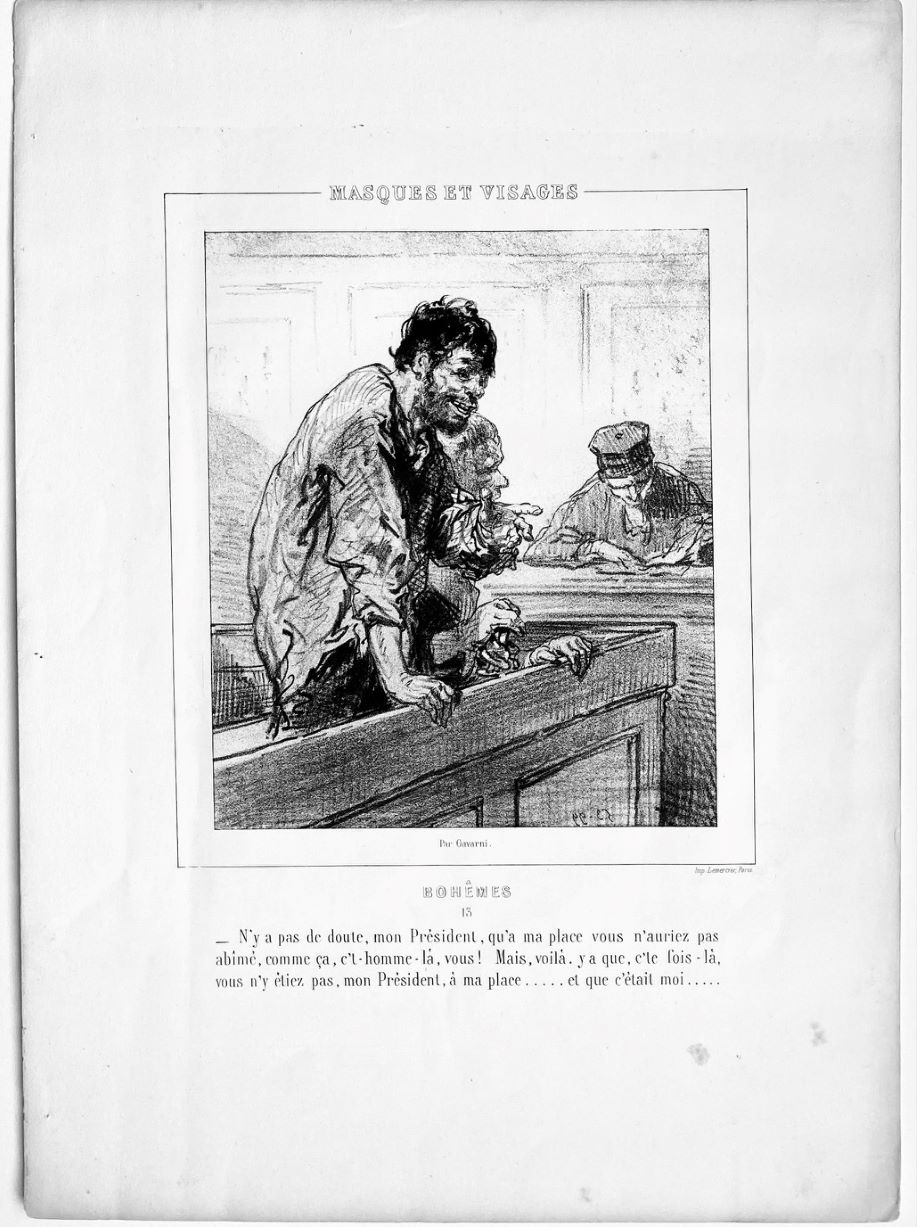![]()
Paul Gavarni (Hippolyte Guillaume Sulpice Chevalier). 1804-1886.

[Justice avocat. (lAWYER].Justice avocat. (LAWYER)]. "N'y a pas de doute, mon Président, qu'à ma place vous n'auriez pas abimé, comme c' homme là vous !...." (There is no doubt, my President, that in my place you would not have wrecked, like that, that man near you! ... ")1857. Lithograph. Image 8 x 6 5/8, image with text 10 1/4 x 7 3/8, sheet 15 3/8 x 11 1/8. Armelhault and Bocher 1269.ii. Bohêmes (Bohemians), from Masques et Visages by Paul Gavarni, New Series. Physionomies Parisiennes, plate 13. The series of 20 lithographs was published in 1857 by Lemercier & Cie, Paris. The figures were half-length or three quarter-length. This is an impression apart from the daily magazine, printed sur blanc. Accompanied by the original lithographic stone: image 8 x 6 5/8, stone 13 x 9 5/8 x 1 1/2 inches and weighs 19 pounds, 2 ounces. It is interesting to note that the stone contains only the image, not the text, which was later added when the complete lithograph was printed. Addit6ionally, the image is presented in the same direction on the stone and in the lithograph. Price upon request.
![]()
Drawing or painting the image directly on the stone required the artist or craftsman to produce the image in reverse so that it would be right-reading when printed. One remedy for this was to draw the image right-reading on a lithographic stone, called the mother stone, which was then printed onto paper. The paper print was immediately run through the press again with a fresh stone, transferring the ink, and creating a daughter stone in which the image was reversed. This could be done several times so that several images could be applied to the daughter stone that were then printed at once, like labels. This also allowed for longer print runs as the original image on the mother stone was protected from the wear and tear of printing. Transfer lithography also allowed the image to be drawn right-reading. The image was made on a special transfer paper coated in a soluble substance like gelatin, which was then wetted and placed face down on the stone. The greasy ink in the image areas stuck to the stone and the non-image areas washed away. Transfer lithographs from intaglio plates were popular in the 1850s. The intaglio plate was printed onto the special transfer paper which was then transferred to stone. This coincided with the introduction of steam powered presses which allowed for very fast and inexpensive reproduction of images. Transfer lithography became an efficient and cost-effective way to reproduce not only existing intaglio images that were in high demand commercially, but also more utilitarian items like labels. Additionally, an image could be printed onto rubber which was stretched or reduced and then transferred to the stone creating enlargements or reductions.
The above information was taken from graphicatlas.org online: Lithography.
![]()
![]()
To order, to report broken links or to be placed on the email list, please contact Jane Allinson (jane@allinsongallery.com), call (001) 860 429 2322 or fax (001) 860 429 2825. Business hours are 9:A.M. to 5 P.M. Eastern Standard Time.
Please click here to review the USE AND ACCEPTANCE AND PRIVACY POLICIES FOR THE ALLINSON GALLERY, INC. WEBSITE
Thank you for visiting this website.